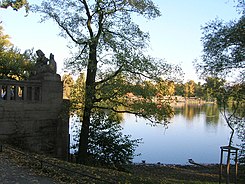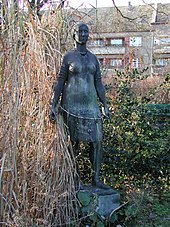Park at the White Lake
| Park at the White Lake | |
|---|---|
| Park in Berlin | |

|
|
| Park on the White Lake with a viewing terrace | |
| Basic data | |
| place | Berlin |
| District | Weissensee |
| Created | 19th century |
| Surrounding streets | Albertinenstraße, Amalienstraße, Parkstraße (all west), Große Seestraße (north), Berliner Allee (east and south) |
| Buildings | Milk house, animal enclosure |
| use | |
| User groups | Foot traffic ; Leisure , events |
| Technical specifications | |
| Parking area | 21,000 m² |
The Park am Weißen See is a Berlin green space in the district of Pankow , district of Weißensee . The park that surrounds the White Lake was created in the 19th century. The milk house , a small game reserve, numerous sculptures and tree monuments are located on its 2.1 hectare area . A 1.3-kilometer circular path within the park leads completely around the lake.
history
At the beginning of the 19th century, the farmer and schnapps distiller Johann Heinrich Leberecht Pistorius had an estate garden laid out around the White Lake. After his death in 1858, the government councilor Friedrich Wilhelm Lüdersdorff acquired the property and added a two-story manor house, the spacious building of which became known as Schloss Weißensee . In 1874 Lüdersdorff leased the site. The popular excursion restaurant Zum Sternecker became the manor house . Here the visitors were offered many attractions such as a lake theater built into the lake , some music pavilions, several sales pavilions, a shooting range, a diving pool, a giant carousel , a ferris wheel and a slide .
At the beginning of the 20th century, the entire complex became the property of the municipality of Weißensee, which transformed it into a public and public park called Trianonpark . A historical postcard from 1918 shows the use of this name. The name Trianonpark on Berliner Allee lasted until the address book in 1940, where it was added with the addition “s. Weißenseer Park ”. During the renovations, playgrounds were created, the paved meadow with water-spouting sandstone figures, a covered viewing terrace, a promenade and a small wildlife enclosure. During the First World War , the castle was used as a barracks . On February 21, 1919 the house burned down completely. The advertised new name for the park did not catch on.
In the 1950s, the district administration had some changes carried out in the park, an open-air stage and a swimming fountain were built. In 1963 the Weißensee Flower Festival was launched, a three-day culture and music festival. In 1987 - as part of the city's 750th anniversary celebrations - a large parade of flowers and vehicles was added. Other parts of Weißensee were included in this vehicle move, such as Pistoriusplatz, Woelckpromenade, the former horse market, Parkstrasse etc. There were sales outlets, a flea market and, based on the history of Weißensee, a bivouac in 1813 .
After the fall of the Wall , from 1995 to 1999, the last renovation and reconstruction work took place in the park.
The park in the 21st century
particularities
In the past , the animal enclosure housed a stag Heinrich , who in 1960 became a literary monument with the children's book of the same name by Fred Rodrian with illustrations by Werner Klemke . Since the beginning of the new century, only damn cows have been standing here, as the deer with antlers was moved to the Blankenfelde-Pankow Botanical Facility because of the care required and vandalism .
In addition to several children's playgrounds on a total of 4500 m², the paddling pool next to the deer enclosure should be mentioned in particular.
There is a part of the park that is suitable for the disabled. The home for the blind, east of the lake, has a separate part of the park with a circular walkway. The neighboring Stephanus Foundation offers its residents walks in the park.
The historic milk house is a gastronomic facility with an open terrace on the lake. At the time of construction, the building served as a sales point for milk and milk products for the municipal hospital and was connected to the milk spa . The pumps required for cooling the milk were supplied from the lake water. In the GDR era, the restaurant was operated by the HO .
The outdoor pool, which opened in 1912, is still open as the Weißensee lido , even if the fire damage in 2004 put a considerable financial burden on the owners. The lido has the second gastronomic facility on the lake, which bears the name Überseebar and spreads an exotic flair with palm trees in the tub and tables on the bathing terrace and in the beach sand. Next to the lido is a flower clock designed as a sundial .
The open-air stage is used as a summer cinema and as a location for cultural events. The cultural offer is complemented by a boat rental on the east bank of the lake, which opened in the 1970s, and the rose garden at the west exit of the park.
Trees
The trees, some of which are 150 years old, offer many visitors a special experience of nature. The following protected trees in particular are listed as natural monuments in Berlin's list:
| tree | Age | Job | link |
|---|---|---|---|
| buckeye | 180 years | above the lake terraces at the playground | |
| Loquat-leaved sessile oak | ? | ? | |
| Summer linden tree | 130 years | on the circular route south of the "milk house" | |
| Black walnut | 120 years | in the part of the park on Albertinenstrasse | |
| Bitter nut | 70 years | ||
| Turkey | 110 years | Albertinenstrasse 6–8 |
Monuments and sculptures
There are several monuments and sculptures in the park. On the corner pillars of the viewing terrace are two tritons created by Hans Schellhorn in 1912 . On the edge of the park near the corner of Amalienstraße and Albertinenstraße are the “Reading Girls” and “Raufenden Knaben”, also by Hans Schellhorn. In this part of the park, also known as Amalienpark , the "construction worker" has been standing since 1968 , dedicated to the women who cleared up the inner city after the Second World War and was designed by Eberhard Bachmann . To the north of the circular path, near the open-air stage, is Christa Collector's “Young Worker” . The "Monument to the Anti-Fascist Resistance Fighters" at the southern exit near Berliner Allee was created by students from the Weißensee art college .
The white lake
Emergence
The Vistula Ice Age formed the lake with the surrounding landscape. The later ice remnants, which were formed by the inland ice advancing from the north, thawed and left a so-called dead lake . Today's White Lake was created from this dead lake, which is surrounded by an undeveloped green strip. Settlements and gardens were built on the lake over the centuries, which were mainly used for agriculture, the first settlement is known from the 13th century. Thanks to the White Lake, Weißensee became an important Berlin excursion area and later a district.
Water stock
With a maximum depth of 9.7 m, the White Lake is one of the deepest bodies of water in Berlin . The almost circular lake has an extension of around 305 m in east-west direction and 350 m in north-south direction. This results in an area of 84,000 m² and a volume of 350,000 m³. In the last 150 years, the water balance has been increasingly disturbed because of the buildings near the shore, with the underground connections to neighboring pools being interrupted.
In order to preserve the White Lake as bathing and recreational water, measures to control the water quality of the lake have been carried out since 1980, which is why the lake can be used for bathing without any problems. The characteristic fountain , which contributed significantly to the aeration of the lake, was worn out after a long period of use in winter 2008/2009 and was expanded. On the occasion of the flower festival in August 2009, a new fountain was put into operation.
literature
- Folkwin Wendland: Berlin's gardens and parks from the founding of the city to the end of the nineteenth century (The classic Berlin). Propylaeen, Berlin 1979, ISBN 3-549-06645-7 , p. 320f.
- Peter Glass: There is a very nice garden there. The park at the White Lake . AG Verlag, Berlin 1999, ISBN 3-933210-03-8 .
Web links
- Environmental sheet The White Lake
- Park am Weißen See Senate Department for Urban Development
- Detailed plan of the park
- Weißensee open-air stage
Individual evidence
- ↑ Trianon Park . In: Berliner Adreßbuch , 1920, part 5, Weißensee, p. 479 (official dedication; already 1918).
- ↑ ak-ansichtskarten.de
- ↑ Trianon Park . In: Berliner Adreßbuch , 1940, Part IV, p. 2373. “Weißenseer Park: Green between Berliner Allee and Albertinenstrasse”.
- ↑ History of the Flower Festival ( Memento from November 25, 2010 in the Internet Archive ) BA Pankow; Retrieved March 22, 2009.
- ↑ City trees: The medlar-leaved grape oak in the park at the White Lake
- ↑ City trees: The summer lime tree in the park on the White Lake
- ↑ City trees: The black walnut in the park on the White Lake
- ↑ City trees: The Zerr oak in Weissensee
Coordinates: 52 ° 33 '15 " N , 13 ° 27' 50.5" E





